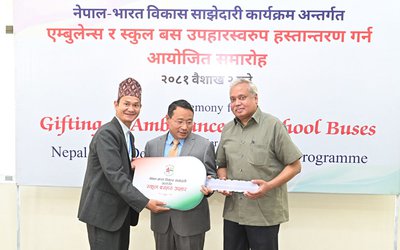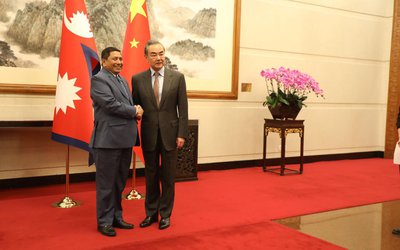
Devastated by the earthquakes in April and May, Kathmandu had many things to share with the international community at a symposium. With narrow roads and haphazard growth, Kathmandu’s urbanization is still regarded as a major threat in the event of future earthquakes, which are expected any time again.
As Nepal is highly vulnerable to seismic activities, the international symposium focused on various facets of urban safety and helped Nepalese experts to learn from the experience of others about the possible ways to make the urban areas safe and secure from future earthquakes.
Inaugurated by Minister of Industry Som Prasad Pandey, the 14th International Symposium on New Technology for Urban Safety of Megacities in Asia was the first of its kind hosted in Nepal after the April-May earthquakes. The Gorkha Earthquake killed about 9,000 people and left more than 8,00,000 families homeless.
“We have learned a lot about safety after the earthquakes. Nepal Government will rebuild earthquake devastated buildings into safer and better structures ensuring disaster resilience,” said minister Pandey.
At the inaugural session chaired by NSET President Shiva Bahadur Pradhanang, MP Gangalal Tuladhar, Japanese ambassador to Nepal Masashi Ogawa, JICA’s Nepal representative Tsutomu Shimizu, Prof. Kimiro Meguro - Director of ICUS, IIS, The University of Tokyo, Japan and Dr. Amod Mani Dixit, Executive Director of NSET, Nepal also shared their views.
The overall objective of the symposium was to share experiences on urban disaster safety and environmental management across the countries in the world by holding interactions among scientists, researchers, academics and decision makers from different countries.
“The government is ready to collaborate with the private sector, civil society and international origanisations to build Nepal’s urban settlements safer and more secure in the event of future disasters,” said Minister Pandey.
According to NSET, 87 scientific papers were presented in a two-day schedule comprising 7 keynote presentations focusing on different sectors such as Disaster Risk Management, Urban Planning and Environmental considerations.
With the participation of 250 people from eight different countries, the participants intensively engaged in the scientific discourses to share, learn and discuss on various facets of urban disaster safety including lessons of Gorkha Earthquake.
This symposium was proposed to be organized in Nepal during the closing ceremony of 13th USMCA which was held in Myanmar in November 2014. Nepal is regarded as an ideal place considering the high risk of different disasters in Nepal as well as continuous efforts of different organizations to reduce the risk. After the Gorkha Earthquake in Nepal, relevance of this symposium has increased further.
“This was the right time to host the international symposium as Nepal needs to learn from the international experiences of making the cities safer and more resilient against any disaster including earthquake,” said Amod Mani Dixit, executive director of NSET.
Following the earthquake of April 25, Nepal has already announced new building codes and guidelines for urban development and construction of houses. Given Nepal’s bad history of poor execution, nobody, however, can be sure that present guidelines are implemented properly.
Along with making the buildings safe and resilient in urban centers, Nepal has to be able to address the issues of rural sectors, which are more prone to disasters. With the drastic change in intensity of rainfall, flash floods and landslides, the two day international symposium had taken up to discuss the urban safety issue.
- TANAHU HYDROPOWER PROEJCT: A Significant Achievement
- Apr 15, 2024
- AMBASSADOR HANAN GODAR: Sharing Pain With A Nepali Family
- Mar 30, 2024
- VISIT OF KfW AND EIB TO NEPAL : Mission Matters
- Mar 25, 2024
- NEPAL BRITAIN SOCIETY: Pratima Pande's Leadership
- Mar 24, 2024
- NEPAL ARMY DAY: Time To Recall Glory
- Mar 15, 2024
















